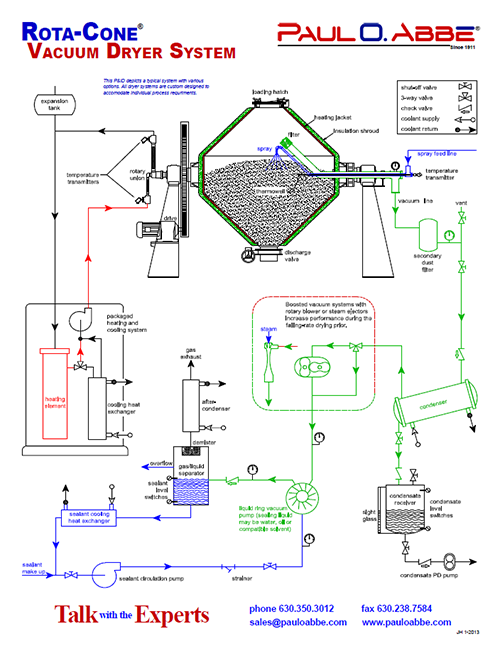Vacuum Dryer System Overview
The vacuum dryer is only one part of a dryer system. Two other pieces of ancillary equipment are needed to complete the system – heat and vacuum.
The fluid heating and circulating system provides the thermal energy for heating the dryer to temperature and then heat for the evaporation of the fluid. A vacuum system is needed to reduce the pressure in the vessel, thus decreasing the evaporative temperature of the fluid and also to remove the vapor generated during drying.

No matter what the temperature or vacuum level, water for example, requires 970 BTU’s per pound to vaporize. A vacuum dryer provides the energy for evaporation indirectly, that is, the solids and liquids are in contact with the inside of the vessel and the heating fluid is isolated in the jacket surrounding the vessel, therefore, the heating fluid is indirectly heating the solids.
Heating fluids may be water or water/glycol for lower temperature (≲250°F) or thermal fluid (a type of oil) for temperatures up to 650°F. Hot oil can also be use at the lower end of the temperature range. The heat is typically generated by electric coils submerged in the fluid and circulated through the heating jacket by a gear or centrifugal pump. Temperature monitoring and control allows precise control of the jacket temperature.
Heat transfer is limited by the surface area of the jacketed vessel and the overall heat transfer coefficient expressed in BTU’s/°F/ft2/hour. The driving force for evaporation then becomes the differential between the jacket temperature of the vaporization temperature of the fluid. In the vase of water that is 212°F at atmospheric pressure, but at modest vacuum level, say 15 Torr (mmHg), water evaporates at about 52°F, thus increasing the temperature differential an additional 160°F, regardless of the jacket temperature. This not only increases thermal efficiency, but also allows the drying of heat sensitive products with as little as 80°F to 100°F in the jacket.
Vacuum is generated in a number of ways, the most common being a liquid ring pump with or without a booster (venturi educator(s) or twin lobe blower). The sealing liquid is typically water or in the case of solvents removal the sealing fluid can be the same or compatible solvent. More exotic pumps are sometimes used including dry pumps that pass vapor directly through without mixing with a sealing fluid.
In the case of large quantities of water or solvent, or when the solvent is valuable or a pollutant, solvent recovery is achieved by placing a condenser between the dryer and the vacuum system. In the case of large quantities of water or solvent being remove, a condenser is absolutely necessary to prevent the vacuum pump from being overloaded. Condensers require cooling water which, depending on the solvent and depth of vacuum, may be cooling tower water, well/city water or for deeper vacuum of low boiling point solvents, a chiller may be needed to obtain temperatures low enough for vapor to condense while still under vacuum in the condenser.
Selecting the right vacuum and solvent recovery system is quite complicated and requires detailed information about the solvent or solvents being removed, volume of vapor being generated per unit time, final depth of vacuum and percent solvent that must be recovered. Unlike many vacuum systems found in industry, a dryer vacuum system must do two jobs equally well. It must be capable of handling large volumes of vapor at the beginning of the drying cycle and obtain deep vacuum at the end of the drying cycle.
